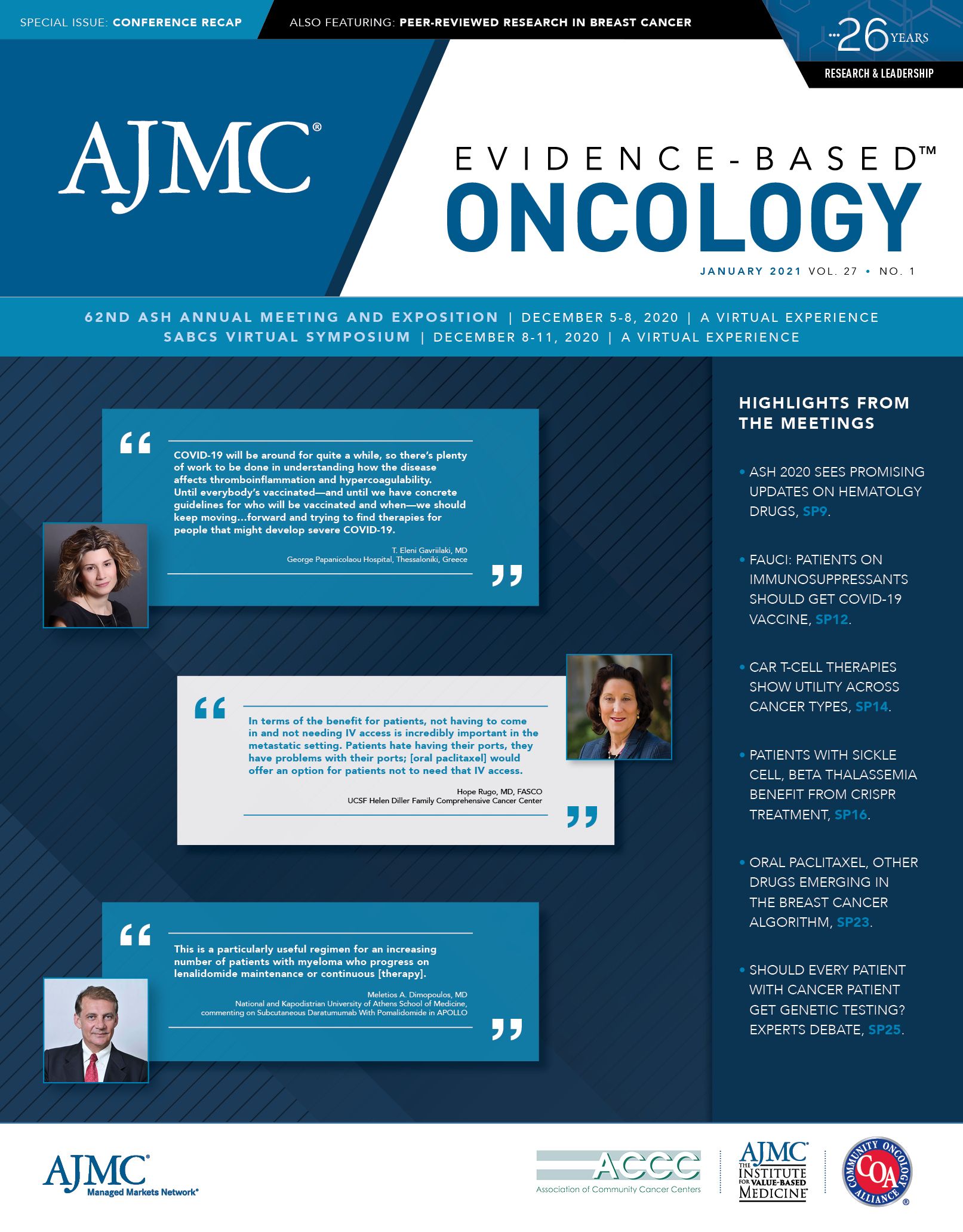Publication
Peer-Reviewed
Evidence-Based Oncology
Clinical and Economic Burden of Intravenous Paclitaxel or nab-Paclitaxel for Metastatic Breast Cancer
Author(s):
This article describes treatment patterns, toxicities, and health care service utilization and costs of women with metastatic breast cancer (mBC) initiating treatment with intravenous (IV) paclitaxel or IV nab-paclitaxel.
ABSTRACT
Background: Intravenous (IV) taxane therapy for metastatic breast cancer (mBC) has been associated with toxicities and demanding dosing schedules, which can limit treatment
effectiveness.
Objectives: To assess treatment patterns, toxicities, and costs in women with mBC initiating IV paclitaxel or IV nab-paclitaxel.
Methods: Adult women diagnosed with BC from January 1, 2014, to September 30, 2018, were identified in the MarketScan Commercial and MarketScan Medicare Supplemental databases. Women had a metastatic disease diagnosis and newly initiated treatment with IV paclitaxel/nab-paclitaxel (first administration date was considered the index date), and continuous enrollment for at least 12 months prior to and at least 3 months following the index date. Treatment discontinuation, dose reductions, toxicities, and health care utilization and costs per patient per month (PPPM) were assessed over the full follow-up and the index line of IV paclitaxel/nab-paclitaxel therapy (Index LOT).
Results: The sample included 8890 women aged 54.6 (±10.9) years, followed for 18.9 (±13.5) months. Most (82.0%) initiated IV paclitaxel/nab-paclitaxel monotherapy; 83.1% had early discontinuation (<18 weeks of treatment) of the Index LOT. Among the 6943 women eligible for the dose-change analysis, 42.4% evidenced an IV paclitaxel/nab-paclitaxel dose reduction ≥10% during the Index LOT. The most common toxicities during the Index LOT were gastrointestinal upset (30.5%), myelotoxicity (27.0%), infection (26.2%), general symptoms (25.9%), and chemotherapy-induced peripheral neuropathy (22.7%). Over follow-up, 39.7% of women had an inpatient admission and 43.0% had an emergency department visit. The mean of all-cause total costs was $11,991 PPPM, while BC-related total costs were $5320 PPPM.
Conclusions: Many mBC patients initiating IV paclitaxel/nab-paclitaxel experienced dose reductions, toxicities, and/or early discontinuation of the Index LOT, which may limit treatment effectiveness. More tolerable treatments with reduced dosing complexity could improve mBC treatment and help contain costs.
Key Words: metastatic breast cancer, chemotherapy treatment patterns, health care service utilization and costs.
Am J Manag Care. 2021;27(Spec 1). Published online December 23, 2020. https://doi.org/10.37765/ajmc.2021.88561
TAKEAWAY POINTS
Early discontinuation, dose reductions, and toxicities are common among women with mBC initiating IV paclitaxel or IV nab-paclitaxel, and they may impact the effectiveness of treatment and longterm patient outcomes. Further, the economic burden among patients treated with IV paclitaxel or nab-paclitaxel is substantial at $11,991 per patient per month, or approximately $143,892 annually. Treatments with improved tolerability stand to improve the clinical burden for patients and economic burden on the health care system.
- 83.1% of women with mBC discontinued IV paclitaxel/nab-paclitaxel early, and 42.1% had a dose reduction.
- 78.6% of patients experienced a toxicity requiring medical attention while on IV paclitaxel/nab-paclitaxel.
INTRODUCTION
In 2020, an estimated 279,100 women will be newly diagnosed with breast cancer (BC) in the United States, representing 30.5% of all new cancer diagnoses in women.1 Among this group, about 6% have distant metastases at diagnosis (mBC)2; the remainder of women with mBC experience progression from earlier-stage BC.3,4 While the overall mortality rate for BC has decreased by 40% since 1989,3 it remains the leading cause of death for women aged 45 to 64 years, as estimated 5-year relative survival for mBC is only 27%.1,5
Despite improvements in detection and treatment, mBC remains incurable; therapy aims to ameliorate symptoms, delay disease progression, and improve quality of life and survival.6 Intravenous (IV) taxanes (paclitaxel, nab-paclitaxel, docetaxel) have been foundational BC treatments for the last 3 decades.7,8
Despite the efficacy of taxanes in extending survival, many patients experience dose-limiting adverse effects (AEs) including infusion reactions, chemotherapy-induced peripheral neuropathy (CIPN), and myeloid cytopenia.7,9
Further, management of BC is associated with high health care costs.10,11 Costs vary by stage, with mBC patients incurring the highest costs of care, estimated at $134,682 per patient in the year following diagnosis; cumulative costs are estimated at $270,033 to $588,491 for patients who survive ≥3 years after mBC diagnosis.10,12 Chemotherapy is the primary cost driver10,13; however, correlations have been reported between treatment-related toxicities and higher health care costs.14,15
Although some data exist on the economic burden of mBC, limited data are available on the specific costs of care with IV paclitaxel and IV nab-paclitaxel treatment.14,16 This observational, retrospective study used administrative claims data to examine treatment patterns, toxicities, health care resource utilization (HCRU), and health care costs among women with mBC initiating treatment with IV paclitaxel or IV nab-paclitaxel.
METHODS
Data Source
This observational retrospective analysis utilized the deidentified IBM MarketScan Commercial Claims and Encounters (commercial) and MarketScan Medicare Supplemental (Medicare) administrative claims databases for the period November 1, 2012, to December 31, 2018. The commercial database contains the inpatient, outpatient, and outpatient prescription drug experience of employees and their dependents, covered under a variety of health plans.
The Medicare database contains the full health care experience (both medical and pharmacy) of retirees with Medicare supplemental insurance provided by employers; Medicare and employer covered portions of payments are included. All study data were obtained using National Drug Codes and codes from International Classification of Diseases, Clinical Modification, 9th and 10th revisions (ICD-9-CM and ICD-10-CM); from Current Procedural Terminology, 4th edition; and from Healthcare Common Procedure Coding System.
Patient Selection and Study Periods
Women with ≥ 1 inpatient or ≥ 2 nondiagnostic outpatient claims with a diagnosis of BC (ICD-9-CM: 174.xx; ICD-10-CM: C50.xx) from January 1, 2014, through September 30, 2018, were identified within the MarketScan databases. Women were also required to have ≥ 1 nondiagnostic claim with a diagnosis of metastasis occurring 60 days prior to the first BC claim through the end of data (excludes codes for metastasis to the breast) and ≥ 1 claim for IV paclitaxel or IV nab-paclitaxel (hereafter referred to as IV paclitaxel/nab-paclitaxel) in the outpatient medical setting following the diagnosis of metastasis. The index date was the date of first administration of IV paclitaxel/nab-paclitaxel.
Eligible women had to be ≥ 18 years on the index date and have continuous enrollment with medical and pharmacy benefits for ≥12 months prior (preperiod) to and ≥ 3 months following the index date. Patients who received any IV taxane in the 12-month preperiod or >1 taxane on the index date were excluded (to isolate impact of paclitaxel). The variable follow-up period extended from index until the earliest of: (1) docetaxel administration; (2) end of continuous enrollment; or (3) end of the study period (December 31, 2018).
Lines of Therapy and Dose Changes
The first line of IV paclitaxel/nab-paclitaxel therapy, starting on the index date, was defined. Index line of therapy (LOT) components included IV paclitaxel/nab-paclitaxel and all chemotherapy agents (capecitabine, carboplatin, cisplatin, cyclophosphamide, doxorubicin, epirubicin, eribulin, flourouracil, gemcitabine, ixabepilone, methotrexate, and vinorelbine) administered in the 37 days following the index date. As patients may have been receiving nontaxane chemotherapy prior to the index date, the 37-day period allowed identification of concomitant medications that were administered on a different cycle. The end of the Index LOT was defined by a regimen change or the end of follow-up; medication discontinuation was defined as a gap in treatment of ≥ 45 days. For patients with a subsequent LOT during follow-up, the components of the second LOT were identified.
Changes in IV paclitaxel/nab-paclitaxel dose were assessed during the Index LOT. Dose was estimated by dividing the paid amount on IV paclitaxel/nab-paclitaxel claims by the wholesale acquisition cost; capitated claims, claims with a JW modifier (indicating medication waste), or a $0 paid amount were excluded. To facilitate assessment of changes over time, only patients with ≥ 3 non-$0 claims for IV paclitaxel/nab-paclitaxel were included in the dose analysis. The magnitude of a dose change was defined as ≥ 10% of the index dose, and dose changes were examined in relation to the prior dose.
Patient Characteristics and Comorbidities
Demographics were measured on index. The National Cancer Institute (NCI) Comorbidity Index and treatment characteristics were examined during the preperiod.17,18 The prevalence and incidence of comorbidities were assessed during the Index LOT and full follow-up. Comorbidities included depression, diabetes, insomnia, falls, fractures, liver dysfunction, rheumatoid arthritis, and nonrheumatoid arthritis (osteoarthritis, psoriatic arthritis, and other polyarthropathies). Patients without a diagnosis of the comorbidity of interest in the preperiod were eligible for the incidence analysis.
Toxicities
Prevalent and incident toxicities were assessed over the Index LOT and the full follow-up; the incident toxicity analysis included only patients without a diagnosis for the toxicity of interest during the preperiod. During the Index LOT, dose changes in the 14 days following a toxicity, and neuropathy medication use in the +/– 10 days around a dose change, were both reported as proxies for toxicity-associated events. Over the full follow-up, hospitalizations or emergency department (ED) visits in the 14 days following an incident toxicity (temporal correlation) were assessed as a proxy for toxicity severity.
Toxicities included alopecia, CIPN, cardiovascular events (angina, atrial fibrillation, atrial flutter, atrioventricular block, cardiac arrest, cardiac tamponade, disseminated intravascular coagulation, heart failure, myocardial infarction, stroke, thromboembolism, and thrombosis), cardiovascular symptoms (bradycardia, chest pain, and tachycardia), general AEs (fever, headache, malaise/fatigue, edema, fluid retention, epistaxis, and dysgeusia/dysosmia), gastrointestinal (GI) events (ascities, colitis, esophagitis, GI bleeding, GI obstruction, GI perforation, pancreatitis, and peptic ulcer) , GI symptoms (constipation, dysphagia, and stomatitis), GI upset (abdominal pain, diarrhea, dyspepsia, and nausea/vomiting), hematological effects, infection, infusion-related/hypersensitivity effects, joint/muscle effects, musculoskeletal effects, myelotoxicity, nervous system effects (ataxia, dizziness, vertigo, syncope, and seizures), encephalopathy, neutropenia, paresthesias, pulmonary events, renal toxicity, and skin effects (full list in Supplemental Materials).
HCRU and Costs
All-cause and BC-related HCRU and costs per patient per month (PPPM), including inpatient admissions, outpatient medical encounters (ED visits, outpatient office visits, and other outpatient services), and outpatient prescriptions were reported over follow-up. BC-related HCRU included inpatient admissions with a diagnosis of BC in the primary position; outpatient services with a diagnosis of BC in any position; medical claims for BC treatments (chemotherapy, endocrine therapy, HER2-directed therapy, or radiation); pharmacy claims for BC; and pharmacy claims for medications prescribed to relieve neuropathy (antidepressants, anticonvulsants, opioids and narcotics, systemic corticosteroids, nonopioid and nonsteroidal pain relief drugs, topical local anesthetics, mexiletine, tocainide, and pentoxifylline). Costs represented the paid amounts of fully adjudicated claims; costs for capitated plans were estimated via payment proxy. All costs were inflated to 2019 US dollars using the medical care component of the Consumer Price Index.19
Statistical Analysis
Mean and SD were reported for continuous variables. Frequencies and percentages were reported for categorical variables. All data analyses were conducted using WPS version 4.1 (World Programming, United Kingdom).
RESULTS
A total of 8890 women with mBC initiating treatment with IV paclitaxel/nab-paclitaxel qualified for the study (Figure).
Figure.
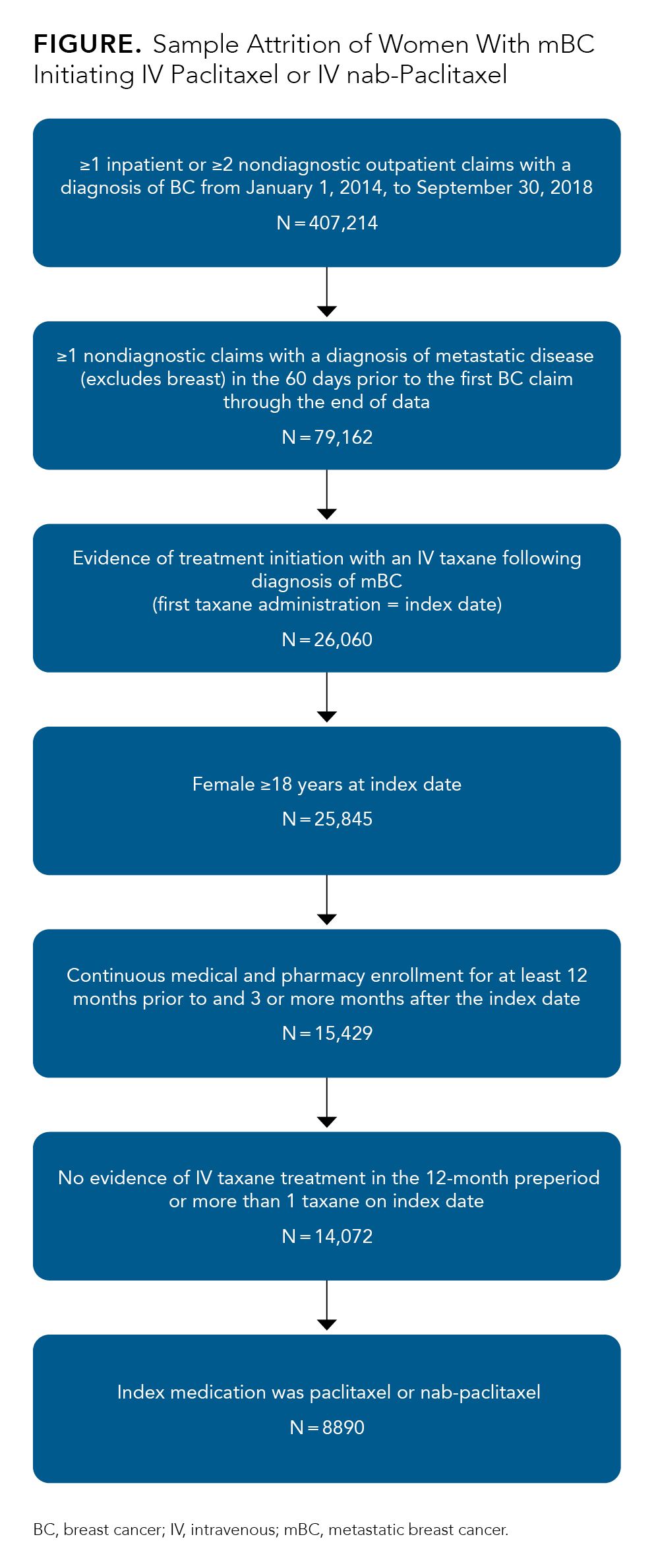
Mean age was 54.6 (±10.9) years at index; mean NCI comorbidity score was 0.6 (±1.0), and patients were followed for a mean of 18.9 (±13.5) months (Table 1).
Table 1.
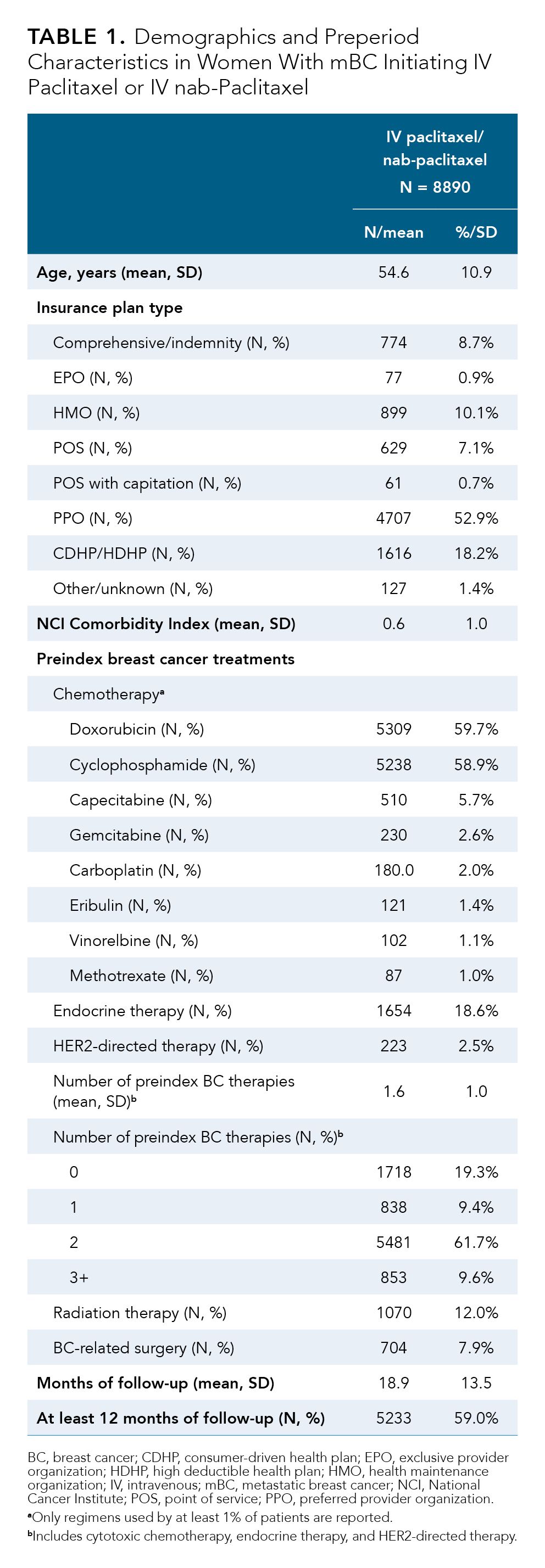
Treatment Characteristics
The most common preperiod chemotherapies were doxorubicin (59.7%) and cyclophosphamide (58.9%; Table 1). Endocrine therapy was used by 18.6% of patients; 2.5% of patients utilized HER2-directed therapy. More than 80% of women received ≥ 1 systemic BC therapy during the preperiod.
Most patients (86.8%) initiated IV paclitaxel on the index date; the remaining 13.2% initiated IV nab-paclitaxel (Table 2). Overall, 82.0% of patients received IV paclitaxel/nab-paclitaxel monotherapy. Among the 1596 patients who received polytherapy (combination with IV paclitaxel/nab-paclitaxel), carboplatin (62.8%), cyclophosphamide and doxorubicin (13.5%), and gemcitabine (7.5%) were the most common other therapy components.
Treatment Changes Over the Index LOT
The duration of the Index LOT was 3.2 (±2.1) months; 77.2% of patients ended their Index LOT due to discontinuation of ≥ 1 regimen medication. Considering that 82.0% of the patients received monotherapy for the Index LOT, IV paclitaxel/nab-paclitaxel was frequently discontinued. Regimen augmentation/switch was observed in 14.1% of women; the remaining 8.7% ended their Index LOT due to the end of follow-up (Table 2). Overall, 83.1% of women had evidence of early discontinuation of the Index LOT, defined as <18 weeks (6 cycles) of therapy.
Table 2.
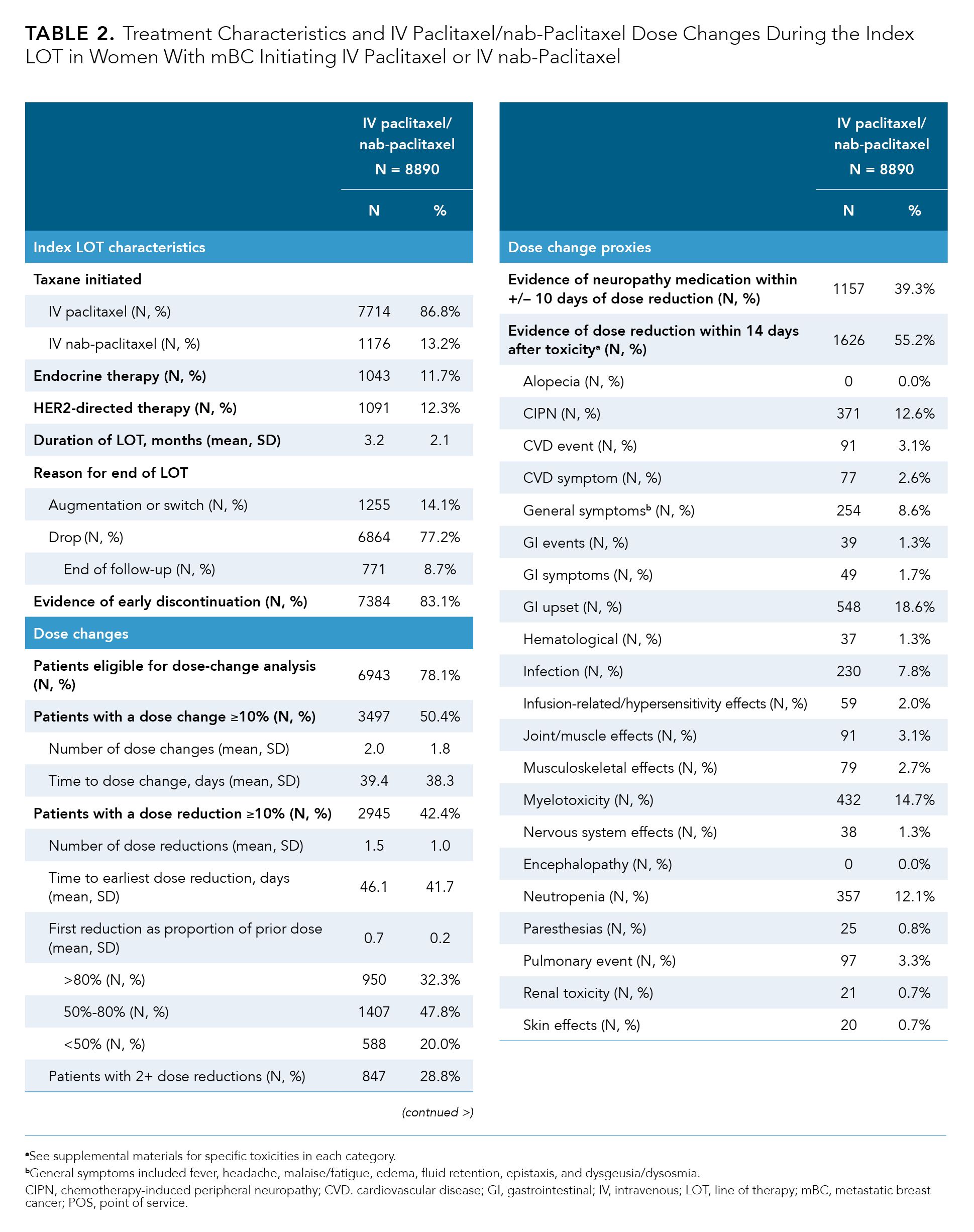
Among the 6943 patients eligible for the dose-change analysis, 3497 (50.4%) evidenced ≥ 1 IV paclitaxel/nab-paclitaxel dose change ≥ 10% over the Index LOT (Table 2). Patients had a mean of 2.0 (±1.8) dose changes; time from index to the first dose change was a mean of 39 (±38) days. A total of 2945 patients (42.4%) had at least 1 dose reduction ≥10%, with a mean of 1.5 (±1.0) reductions per patient. Time to the first dose reduction was a mean of 46 (±42) days, and the mean reduced dose was 70% (±20%) of the prior dose. Of the 2945 patients with a dose reduction during the Index LOT, 1626 (55.2%) evidenced a dose reduction in the 14 days following a toxicity; the most common toxicities prior to dose reduction were GI upset (18.6%), myelotoxicity (14.7%), CIPN (12.6%), and neutropenia (12.1%; Table 2).
Incident Comorbidities and Toxicities
Over the full follow-up period, the most common incident comorbidities were depression (12.3%), liver dysfunction (10.5%), nonrheumatoid arthritis (8.9%), and insomnia (7.4%); incident diabetes, falls, fractures, and rheumatoid arthritis each were observed in less than 5% of the eligible women. Toxicities were common; 95.4% of women had ≥1 prevalent toxicity, with a mean of 5.2 (±3.2) toxicities over the full follow-up (Supplemental Table 1). The most common toxicities were infection (62.3%), general symptoms (53.8%), CIPN (51.6%), GI upset (50.0%), and myelotoxicity (43.3%). During the Index LOT, 78.6% of patients had claims for ≥ 1 prevalent toxicity, with a mean of 2.3 (±2.1) toxicities. The most common toxicities during the Index LOT included GI upset (30.5%), myelotoxicity (27.0%), infection (26.2%), general symptoms (25.9%), and CIPN (22.7%).
Incident toxicities were assessed among the subset of women with no evidence of the toxicity of interest in the preperiod (Table 3). Over the full follow-up, the incidence rate of toxicities ranged from 0.2 cases/100 person-years for alopecia to 56.5 cases/100 person-years for infections. Other common incident toxicities included CIPN, general symptoms, and GI upset with 49.7, 45.5, and 33.4 cases/100 person-years, respectively. Using the presence of hospitalizations or ED visits in the 14 days following the toxicity as a proxy for severity, the most severe toxicities were neurological, renal, and pulmonary events, with 91.4%, 68.2%, and 59.9% of patients, respectively, with a hospitalization/ED visit in the 14 days following the incident toxicity. During the Index LOT, the incidence of toxicities ranged from 0.4 cases/100 person-years for alopecia to 84.7 cases/100 person-years for general symptoms. Common toxicities included CIPN, infection, and GI upset, with 79.4, 79.6, and 77.1 cases/100 person-years, respectively. Neurological, renal, and pulmonary toxicities remained the most severe with 90.2%, 65.7%, and 59.0% of patients, respectively, with a hospitalization/ED visit in the 14 days following the toxicity.
Table 3A.
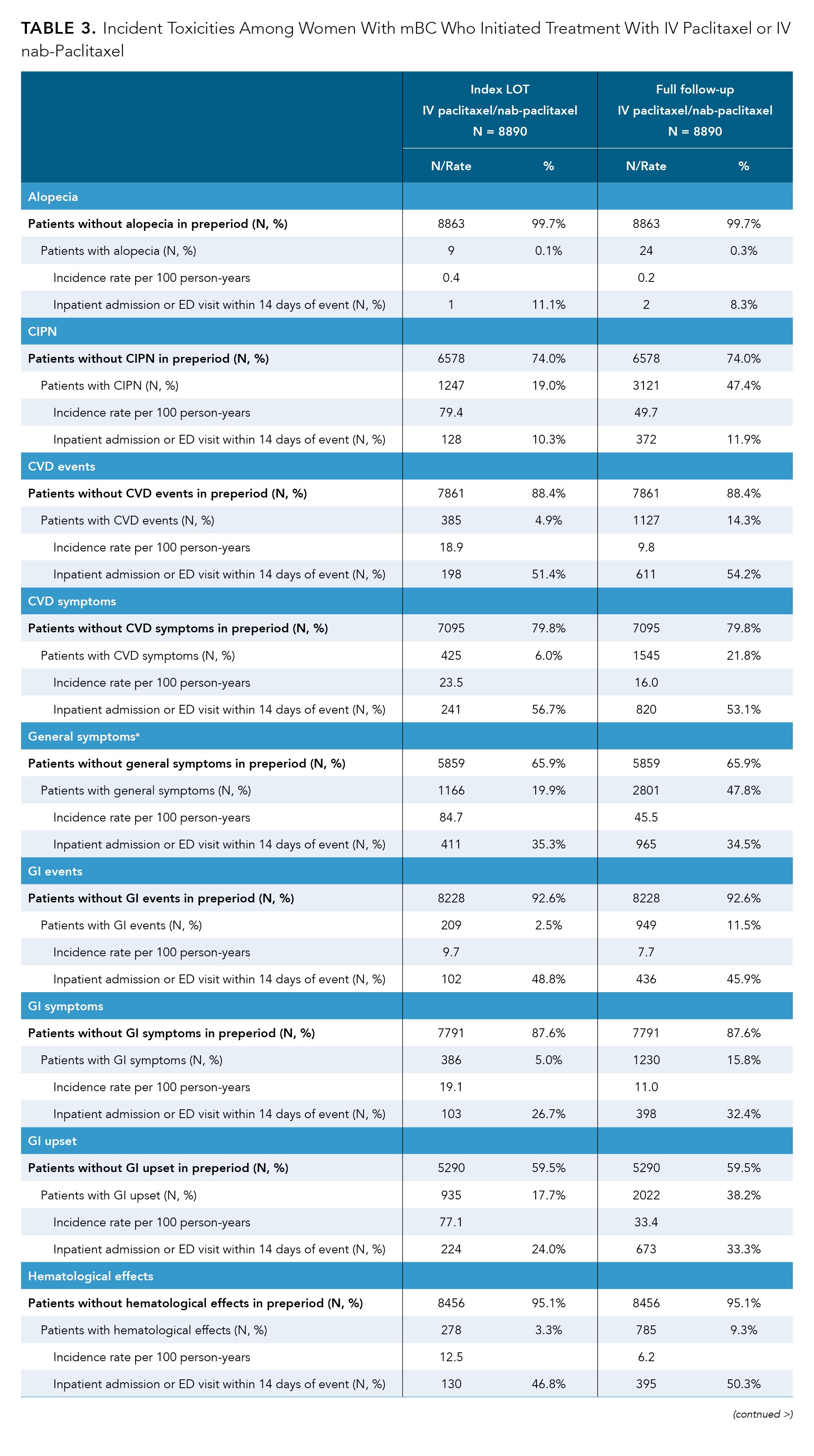
Table 3B.
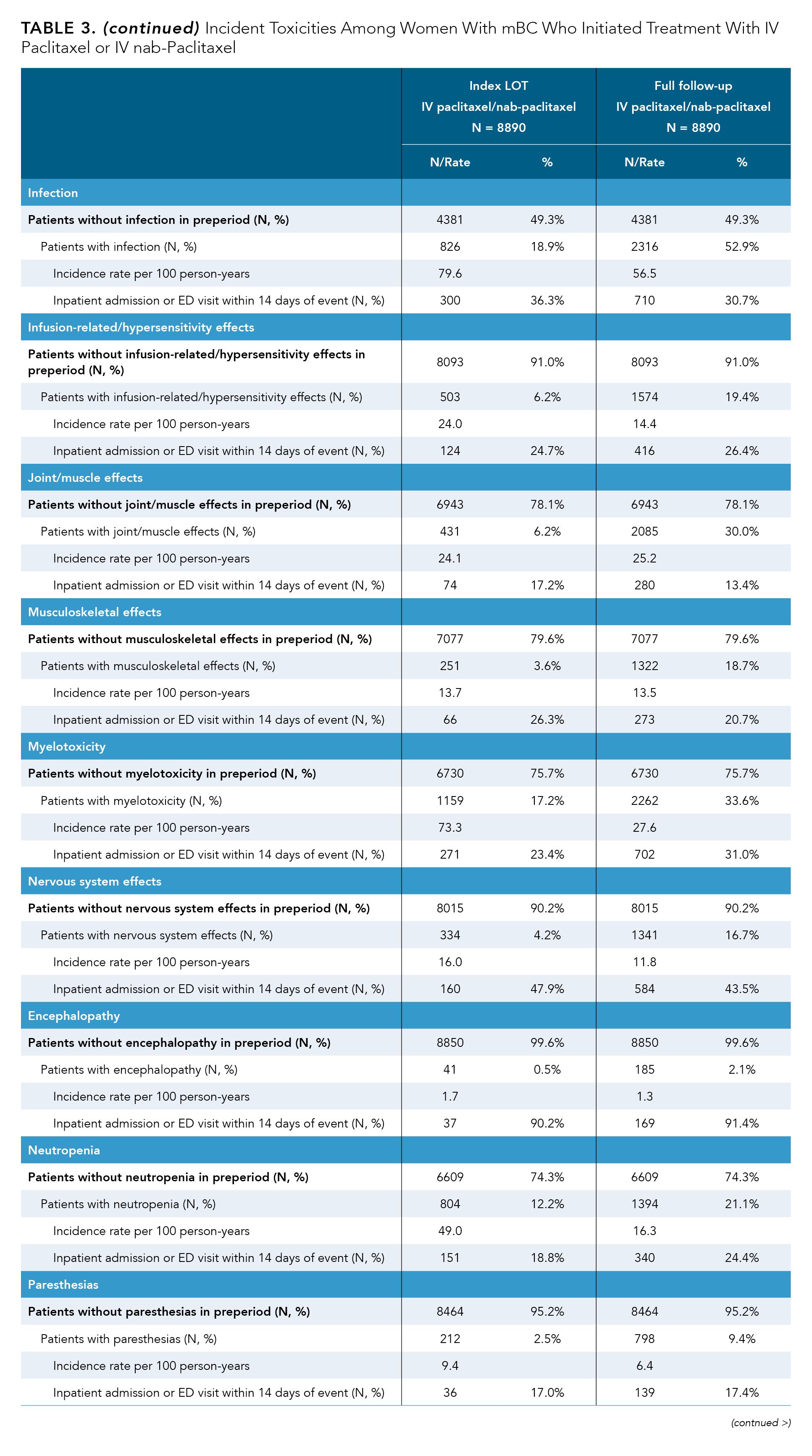
Table 3C.
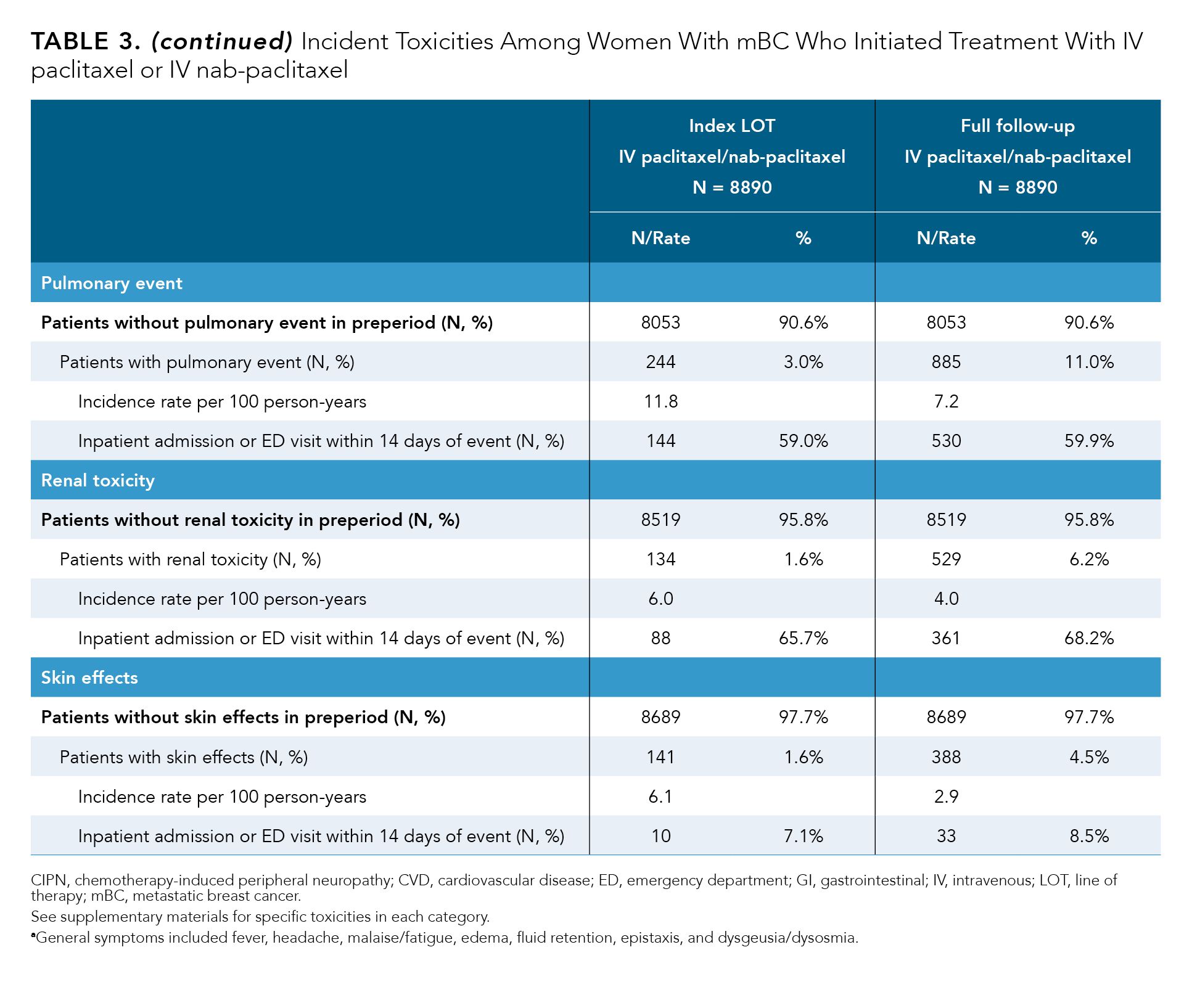
All-Cause HCRU and Costs
During the full follow-up, 39.7% of patients had an inpatient admission and 43.0% had an ED visit (Table 4). Nearly all patients (99.7%) had ≥ 1 outpatient office visit with a mean of 2.0 (±1.1) visits PPPM. All patients had ≥ 1 other outpatient service, which included claims for chemotherapy infusion, with a mean of 6.4 (±3.8) services PPPM. In addition, 98.6% of patients used the outpatient pharmacy, with a mean of 2.9 (±2.2) prescriptions PPPM.
Mean total all-cause costs among patients with mBC treated with IV paclitaxel/nab-paclitaxel were $11,991 (±$11,681) PPPM during the full follow-up period (Table 4). Inpatient costs were $1775 (±4875) PPPM, and all-cause medical costs were $11,274 (±$11,443) PPPM. Other outpatient services were the primary driver of all-cause total costs at $9067(±$9304) PPPM.
Table 4.
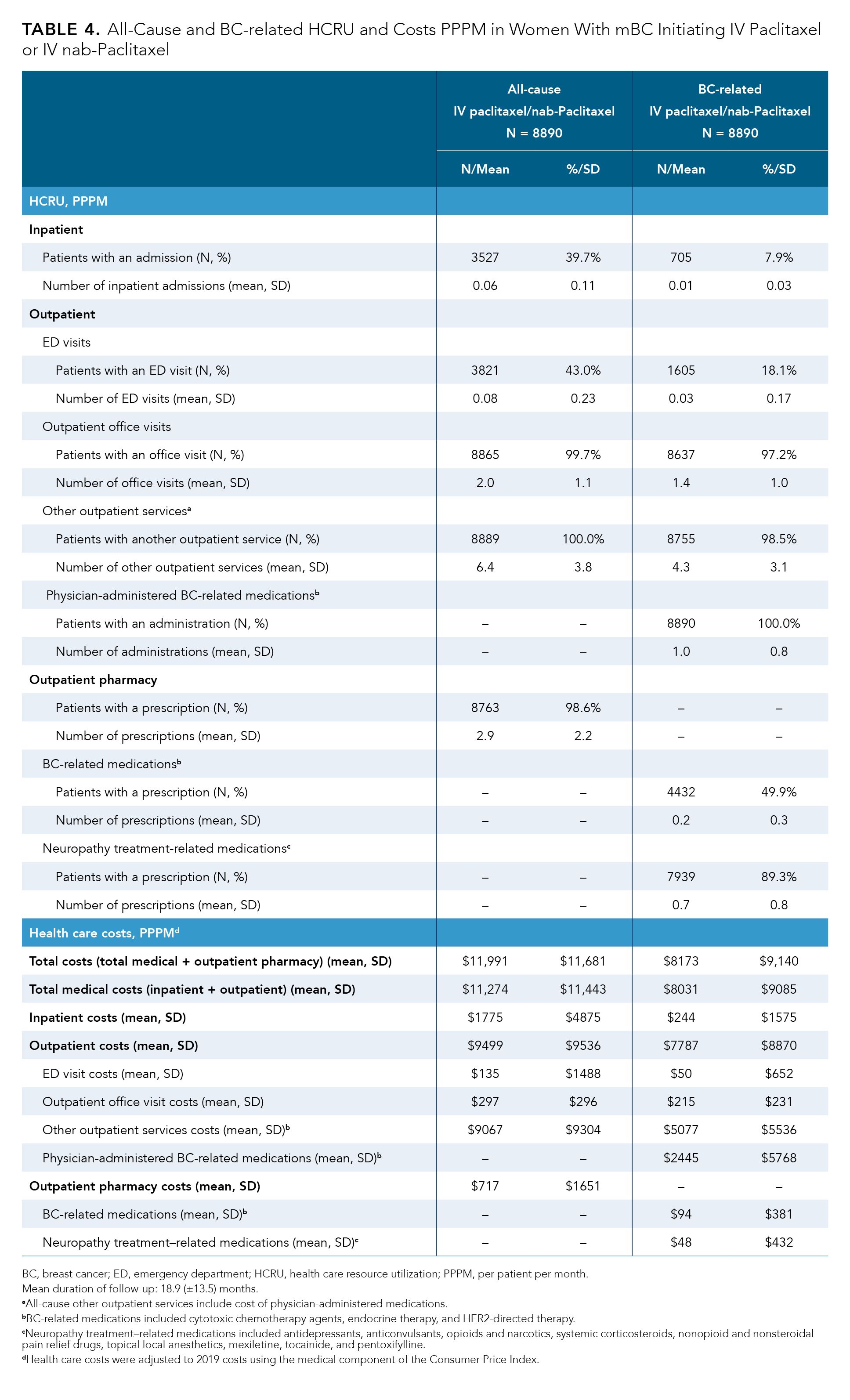
BC-related HCRU and Costs
BC-related HCRU over the full follow-up period was substantial with 7.9%, 18.1%, and 97.2% of patients with ≥ 1 inpatient admission, ED visit, and office visit, respectively (Table 4). While 100% of patients received physician-administered BC-related medications with a mean of 1.0 (±0.8) administrations per month, 98.5% had additional BC-related other outpatient services with a mean of 4.3 (±3.1) services per month. Approximately half of women (49.9%) filled an outpatient prescription for a BC-related medication, and 89.3% of patients filled an outpatient prescription for a medication to treat neuropathy.
Total BC-related costs among patients treated with IV paclitaxel/nab-paclitaxel were $8173 (± $9140) PPPM during the full follow-up (Table 4). BC-related medical costs were $8031 (±$9085) PPPM, with $2445 (±$5768) PPPM from physician-administered BC medications, and another $5077 (±$5536) PPPM representing costs of other outpatient services.
DISCUSSION
In this study of 8890 women with mBC initiating IV paclitaxel or IV nab-paclitaxel, early discontinuation, dose reductions, and toxicities were common over the Index LOT. Early discontinuation occurred in 83.1% of women, and 42.4% of women in the dose-change analysis had ≥ 1 IV paclitaxel/nab-paclitaxel dose reduction ≥ 10%. Toxicities sufficiently serious for the patients to seek medical care (in order for them to be reported in claims data) were observed in 78.6% of women during the Index LOT. Assessment of HCRU and costs over the follow-up revealed that inpatient admissions and hospitalizations were common, and costs were substantial at $11,991 (±$11,681) PPPM, 68.2% of which were BC-related.
Over the Index LOT, 78.6% had evidence of a prevalent toxicity; this rose to 95.4% over the full follow-up. The rate of toxicities observed in this study are in line with previously published reports citing toxicity rates of 68% to 95% in taxane users.14,15 We also identified high rates of incident toxicity both over the Index LOT and full follow-up; the most common were CIPN, general symptoms, and infections, each occurring in approximately 50% of women over the full follow-up. Although a causal relationship between toxicities and treatment changes cannot be established in claims data, the finding that 55.2% of women with a dose reduction during the Index LOT had a dose change in the 14 days following a toxicity diagnosis suggests that toxicities impacted treatment. In a chart review to examine the relationship between toxicities and dose changes, Rashid et al found that 20% of patients with a toxicity had a change to their chemotherapy regimen, which is similar to the 23.4% of women with dose reductions in this study.20
Toxicities do not only impact chemotherapy but can also drive increased HCRU. Multiple studies have reported increased health care costs in patients who experience toxicities.14,15 This study did not specifically address relative health care costs in patients with and without toxicities; however, the presence of ED visits or inpatient admissions was assessed in the 14 days following incident toxicities. Of the 21 toxicities assessed here, ED visits or inpatient admission rates of ≥ 30% were observed for 13 toxicities. Rates of ED visits or inpatient admissions surpassed 50% for incident cardiovascular disease events and symptoms; pulmonary events; and hematological, renal, and encephalopathy.
During the full follow-up, mBC patients treated with IV paclitaxel/nab-paclitaxel in this study incurred mean health care costs of $11,991 PPPM, or approximately $143,892 per patient annually. BC-related costs accounted for more than two-thirds (68.2%) of the monthly all-cause costs at $8173 PPPM or $98,076 per patient per year. For both all-cause and BC-related costs, other outpatient services and physician administration of BC-related medications were the primary cost drivers. Similarly, Hurvitz et al and Hansen et al examined total health care costs for mBC patients during paclitaxel treatment; they found costs ranging from approximately $7500 to $13,000 PPPM depending on LOT and toxicity burden.14,15 Other studies have also assessed the burden of mBC in broader populations (eg, not only taxane treatment) and found costs ranging from approximately $9000 to $11,000 PPPM, which are largely in line with this analysis.10,12,21,22
In aggregate, the treatment changes, discontinuation, dose reductions, toxicities, incident comorbid conditions, and high HCRU and costs incurred by patients with mBC receiving IV paclitaxel/nab-paclitaxeldemonstrate a large burden for patients and the health care system.
Limitations
This descriptive study is subject to several limitations. This analysis was limited to patients with commercial or Medicare supplemental insurance and ≥3 months of postindex enrollment; therefore, results may not generalize to the uninsured, those with other insurance, or patients who die shortly after initiating treatment. Second, there is the potential for clinical misclassification, as patients were identified through administrative claims data, which are subject to miscoding and undercoding. This may be particularly relevant to assessment of toxicities, as less severe conditions that may not require medical intervention (eg, headache) or conditions less likely to be coded (eg, nausea) are likely underreported. It is also extremely difficult to discern cancer severity due to the lack of staging and biomarker information in claims. Third, all dose change analyses were estimated using paid amounts on claims. Due to this methodology, only relative changes in dose were assessed; however, changes in factors such as rebates, variability in price of generic agents, or site of medication administration could impact estimates. Finally, this study cannot identify causal relationships between IV paclitaxel/nab-paclitaxel and toxicity development.
CONCLUSIONS
Alterations in chemotherapy, including early discontinuation and dose reductions, were common among women with mBC initiating IV paclitaxel/nab-paclitaxel in this study. High rates of toxicities were also observed, and proxy measures examining the timing between toxicities and dose reductions found that 55.2% of women with a dose reduction experienced a dose reduction shortly after a toxicity diagnosis. Similarly, high rates of hospitalizations or ED visits following severe incident toxicities (eg, encephalopathy) were observed. Treatments with increased tolerability have the potential to reduce toxicity rates, improve adherence to treatment, and improve patient outcomes. Additionally, the majority of health care costs ($11,991 PPPM or approximately $143,892 annually per patient) in this study were derived from other outpatient services including chemotherapy administration. These findings suggest that chemotherapy and toxicities exert a substantial burden on patients and payers; medications with improved dosing schedules and tolerability could therefore have the potential to reduce the clinical and economic burden of mBC.
AUTHOR AFFILIATIONS: IBM Watson Health, Cambridge, MA (BLB, ML, KW, HV, CLC); Mirador Global, Kennett Square, PA (KMF, CC); Athenex Inc, Buffalo, NY (JW, ID).
AUTHOR INFORMATION: Concept and design (BLB, KW, KMF, JW, CC, HV, ID); acquisition of data (KW, KMF, HV); analysis and interpretation of data (BLB, ML, KW, KMF, JW, CC, HV, CLC, ID): drafting of manuscript (BLB, ML); critical revision of manuscript for important intellectual content (KW, KMF, JW, CC, ID); statistical analysis (CLC); obtaining funding (JW, ID); administrative, technical, and logistical support (ML, KW, HV, CLC); and supervision (KMF, JW, CC, ID).
FUNDING SOURCE: This study was sponsored by Athenex Inc.
CORRESPONDING AUTHOR: Brenna L. Brady, PhD; brenna.brady@ibm.com
AUTHOR DISCLOSURES: BLB, KW, and HV are employed by IBM Watson Health, which received funding from Athenex Inc to perform this study. ML and CLC were employed by IBM Watson Health at the time f this study. KMF and CC are employed by Mirador Global, which received research funding from Athenex Inc to conduct this study. JW and ID are employed by and own stock in Athenex.
This research was presented in part at the 2020 Virtual AMCP Nexus conference.
ACKNOWLEDGMENTS
Medical writing services were provided by Jessamine Winer-Jones of IBM Watson Health.
DATA AVAILABILITY STATEMENT
The data that support the findings of this study are available from IBM Watson Health. Restrictions apply to the availability of these data, which were used under license for this study.
REFERENCES
1. Siegel RL, Miller KD, Jemal A. Cancer statistics, 2020. CA Cancer J Clin. 2020;70(1):7-30. doi:10.3322/caac.21590
2. Cancer stat facts: female breast cancer. National Cancer Institute / Surveillance, Epidemiology, and End Results Program. Accessed June 2020. https://seer.cancer.gov/statfacts/html/breast.html
3. DeSantis CE, Ma J, Gaudet MM, et al. Breast cancer statistics, 2019. CA Cancer J Clin. 2019;69(6):438-451. doi:10.3322/caac.215834
4. Mariotto AB, Etzioni R, Hurlbert M, Penberthy L, Mayer M. Estimation of the number of women living with metastatic breast cancer in the United States. Cancer Epidemiol Biomarkers Prev. 2017;26(6):809-815. doi:10.1158/1055-9965.EPI-16-0889
5. Curtin SC. Trends in cancer and heart disease death rates among adults aged 45-64: United States, 1999-2017. Natl Vital Stat Rep. 2019;68(5):1-9.
6. Waks AG, Winer EP. Breast cancer treatment: a review. JAMA. 2019;321(3):288-300. doi:10.1001/jama.2018.19323
7. Gradishar WJ. Taxanes for the treatment of metastatic breast cancer. Breast Cancer (Auckl). 2012;6:159-171. doi:10.4137/BCBCR.S8205
8. NCCN Clinical Practice Guidelines in Oncology. National Comprehensive Cancer Network (NCCN). Breast cancer, version 4.2020. https://www.nccn.org/professionals/physician_gls/
9. Rowinsky EK, Chaudhry V, Cornblath DR, Donehower RC. Neurotoxicity of taxol. J Natl Cancer Inst Monogr. 1993(15):107-115.
10. Blumen H, Fitch K, Polkus V. Comparison of treatment costs for breast cancer, by tumor stage and type of service. Am Health Drug Benefits. 2016;9(1):23-32.
11. Fu AZ, Jhaveri M. Healthcare cost attributable to recently-diagnosed breast cancer in a privately-insured population in the United States. J Med Econ. 2012;15(4):688-694. doi:10.3111/13696998.2012.673524
12. Ray S, Bonthapally V, McMorrow D, Bonafede M, Landsman-Blumberg P. Patterns of treatment, healthcare utilization and costs by lines of therapy in metastatic breast cancer in a large insured US population. J Comp Eff Res. 2013;2(2):195-206. doi:10.2217/cer.13.1
13. Kruse GB, Amonkar MM, Smith G, Skonieczny DC, Stavrakas S. Analysis of costs associated with administration of intravenous single-drug therapies in metastatic breast cancer in a U.S. population. J Manag Care Pharm. 2008;14(9):844-857. doi:10.18553/jmcp.2008.14.9.844
14. Hansen RN, Ramsey SD, Lalla D, et al. Identification and cost of adverse events in metastatic breast cancer in taxane and capecitabine based regimens. Springerplus. 2014;3:259. doi:10.1186/2193-1801-3-259
15. Hurvitz S, Guerin A, Brammer M, et al. Investigation of adverse-event–related costs for patients with metastatic breast cancer in a real-world setting. Oncologist. 2014;19(9):901-908. doi:10.1634/theoncologist. 2014-0059
16. Force RW, Pugmire BA, Culbertson VL. Comparing medical cost of care for patients with metastatic breast cancer receiving taxane therapy: claims analysis. Am Health Drug Benefits. 2010;3(4):276-284.
17. SEER – Medicare: selecting the appropriate comorbidity SAS macro. National Cancer Institution / Division of Cancer Control & Population Sciences. Updated May 16, 2019. Accessed December 10, 2020. https://healthcaredelivery.cancer.gov/seermedicare/considerations/calculation.
html
18. Cho H, Mariotto AB, Mann BS, Klabunde CN, Feuer EJ. Assessing non–cancer-related health status of US cancer patients: other-cause survival and comorbidity prevalence. Am J Epidemiol. 2013;178(3):339-349. doi:10.1093/aje/kws580
19. Consumer Price Index details report tables. Accessed March 1, 2020. https://www.bls.gov/cpi/home.htm
20. Rashid N, Koh HA, Baca HC, et al. Clinical impact of chemotherapy-related adverse events in patients with metastatic breast cancer in an integrated health care system. J Manag Care Spec Pharm. 2015;21(10):863-871. doi:10.18553/jmcp.2015.21.10.863
21. Montero AJ, Eapen S, Gorin B, Adler P. The economic burden of metastatic breast cancer: a U.S. managed care perspective. Breast Cancer Res Treat. 2012;134(2):815-822. doi:10.1007/s10549-012-2097-2
22. Schwartz KL, Simon MS, Bylsma LC, et al. Clinical and economic burden associated with stage III to IV triple-negative breast cancer: a SEER-Medicare historical cohort study in elderly women in the United States. Cancer. 2018;124(10):2104-2114. doi:10.1002/cncr.31299
